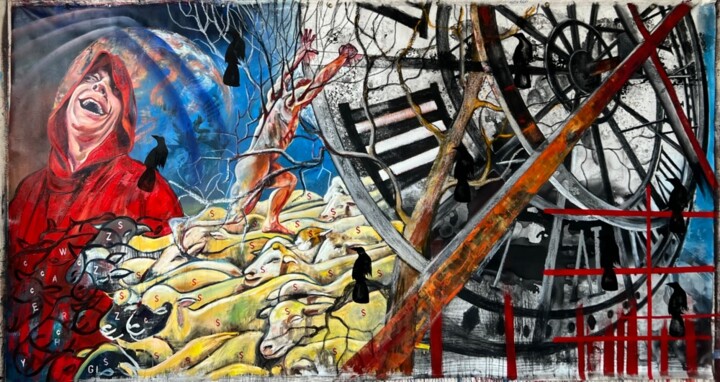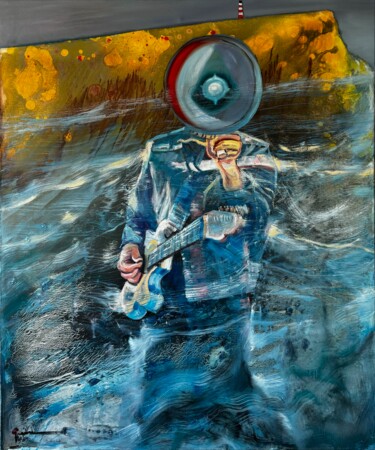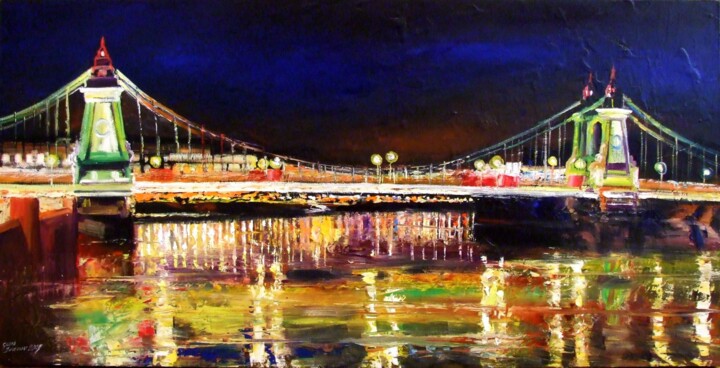Gennadiy V. Ivanov
Nationality:
British
Education:
2010-2011 Graduated for a MA Fine Art Norwich University of the Art.
Membership:
2010-2025 Member of The Outpost Studios
2011-2023 Stray artists group (Cambridge)
2017-2023 Member of Norwich 20 artists group
Work:
From 2005 permanently at the Norwich Studio Art Gallery
2019-2021 Artist-in-Residence, The Canadian Centre for Water Forecasting and Prediction at the University of Saskatchewan, Canada
2022-2024 UNESCO
My works is a wide variety of media, including paintings, installations, drawings, and photography. Bringing these media together into a provocative collision, my work is mine a territory defined by not only the specters of recent world political history but also the deeply flowing social veins of underground style as manifested in the popular culture realms of street art fashion and experimental dance and music.
My works walk a tightrope between West-East remembrance and the rigorous anti-logic of dream analysis while also touching on art historical references ranging from Van Gogh to Frances Bacon.
It might be possible to trace my focus on the vagaries of memory, history and subcultural style to my parallel life as a poet, fiction writer, and historian. My curatorial projects 2014-2018 evidenced a refined display of mine multitasking painterly practice as well as my oneiric* Historical analytic. I am brought into proximity a series of canvases that ranged from quasi-psychedelic non-representational liquid (oily) pours to expressively figurative large-scale canvases. The artworks painterly invocations of phyla-political analysis of the history of the 20-21st century globalist’s masculinity. To my credit, I creates a level of narrative ambiguity in these works that is suggestive without being dogmatic.
My works addressed the acts of looking and seeing, and considers the way in which painting can stake a claim for itself amid the proliferation of contemporary visual formats. Elements from public activities such a walking, literature, music, history, mythology, philosophy and travel appear in this work as a way to make there elements accessible to a broad audience.
Discover contemporary artworks by Gennadiy V. Ivanov, browse recent artworks and buy online. Categories: contemporary british artists. Artistic domains: Painting. Account type: Artist , member since 2008 (Country of origin United Kingdom). Buy Gennadiy V. Ivanov's latest works on ArtMajeur: Discover great art by contemporary artist Gennadiy V. Ivanov. Browse artworks, buy original art or high end prints.

Artist Value, Biography, Artist's studio:
Latest Artworks • 115 artworks
View allRecognition
The artist has won prizes and awards
The artist has been published in the media, radio or TV press
The artist participates in art shows and fairs
Exercises the profession of artist as a main activity
Biography
Nationality:
British
Education:
2010-2011 Graduated for a MA Fine Art Norwich University of the Art.
Membership:
2010-2025 Member of The Outpost Studios
2011-2023 Stray artists group (Cambridge)
2017-2023 Member of Norwich 20 artists group
Work:
From 2005 permanently at the Norwich Studio Art Gallery
2019-2021 Artist-in-Residence, The Canadian Centre for Water Forecasting and Prediction at the University of Saskatchewan, Canada
2022-2024 UNESCO
My works is a wide variety of media, including paintings, installations, drawings, and photography. Bringing these media together into a provocative collision, my work is mine a territory defined by not only the specters of recent world political history but also the deeply flowing social veins of underground style as manifested in the popular culture realms of street art fashion and experimental dance and music.
My works walk a tightrope between West-East remembrance and the rigorous anti-logic of dream analysis while also touching on art historical references ranging from Van Gogh to Frances Bacon.
It might be possible to trace my focus on the vagaries of memory, history and subcultural style to my parallel life as a poet, fiction writer, and historian. My curatorial projects 2014-2018 evidenced a refined display of mine multitasking painterly practice as well as my oneiric* Historical analytic. I am brought into proximity a series of canvases that ranged from quasi-psychedelic non-representational liquid (oily) pours to expressively figurative large-scale canvases. The artworks painterly invocations of phyla-political analysis of the history of the 20-21st century globalist’s masculinity. To my credit, I creates a level of narrative ambiguity in these works that is suggestive without being dogmatic.
My works addressed the acts of looking and seeing, and considers the way in which painting can stake a claim for itself amid the proliferation of contemporary visual formats. Elements from public activities such a walking, literature, music, history, mythology, philosophy and travel appear in this work as a way to make there elements accessible to a broad audience.
-
Nationality:
UNITED KINGDOM

- Date of birth : 1968
- Artistic domains: Works by professional artists,
- Groups: Professional Artist Contemporary British Artists

Ongoing and Upcoming art events
Influences
Education
Artist value certified
Achievements
Prizes and Awards
Collective Expositions
Permanent Collections
Residencies
Solo Expositions
Activity on ArtMajeur
Latest News
All the latest news from contemporary artist Gennadiy V. Ivanov
Mountain Glacier Loss and Snow Drought Threaten Alberta’s Water Security By JOHN POMEROY Paintings by GENNADIY IVANOV



In the 30 years since global leaders first gathered to discuss how to limit climate change under the United Nations Framework Convention on Climate Change, Earth has lost close to 8 trillion tonnes of ice1 and the atmospheric concentration of the potent greenhouse gas, carbon dioxide, has risen from 350 to 430 parts per million2 — a level last experienced about 2.5 million years ago at the beginning of the Pleistocene Epoch in which humans later evolved.
As a result of greenhouse gas concentration increases, temperatures are rising quickly and our weather is becoming more extreme. We now stand on the cusp of major losses to Earth’s major polar ice sheets in Greenland and Antarctica. These changes are happening much sooner than many scientists’ previous worst-case scenarios.3 They spell the end for both low-lying nations and coastal regions, as maps of coastlines are redrawn by rising seas,4 as well as for wildlife such as polar bears, seals, and Antarctic penguins that have evolved to thrive in these frozen zones.
But they are also set to strike all of us, much closer to home. And it’s hard to imagine anywhere that will feel the force of these changes as acutely as Alberta.
Alarming Conditions
Alberta is not only home to the perhaps the world’s best ice hockey and skiing; we are dependent upon the seasonal snowpack to store water over our winters to melt in spring and summer to replenish our rivers, lakes, and wetlands with clean, fresh water. When this winter and spring snow melts in spring and summer, it sustains up to 80% of the flow of the Saskatchewan, Peace, and Athabasca Rivers, which then support our cities, industries, hydropower, and irrigation systems.5 Our Canadian Rockies glaciers adorn some of the most beautiful places on the planet, such as Lake Louise, and form the heart of one of the largest UNESCO World Heritage Sites, the Canadian Rocky Mountains. The importance of mountain glaciers extends beyond Alberta; Canada has over 20,000 of the world’s glaciers and likely more snow than any other country. Their melt over our frozen ground promotes runoff to millions of streams, wetlands, and lakes, providing for productive aquatic ecosystems and hydropower generation.6 This has enriched Canadians, from the original Indigenous societies, to the beaver-fuelled fur trade, to our current hydroelectricity and water-based economy. Water is life, and Canadians enjoy vast freshwater flows and a rich life thanks to our snow and ice.
With the longest coastline in the world, Canada is incredibly vulnerable to coastal flooding from the multi-metre sea level rise that is likely to become a reality towards the second half of the 21st century. Melt of mountain glaciers such as in the Canadian Rockies is currently the largest contributing factor to sea level rise.7 What melts in the Rockies does not stay in the Rockies, and the Canadian Rockies are estimated to have lost 24% of their glacier volume so far this century.8 The local impacts of mountain deglaciation and loss of seasonal snow cover and lake ice is a disaster that is already well underway, as evidenced by our record wildfire seasons caused by forest snow droughts and record-low streamflows in the Bow River and others in 2023, and low flows and widespread agricultural drought in most years since 2015.
And it’s not just snow and glacial ice that we are losing; Canada’s permafrost, or permanently frozen ground, is thawing fast. Our projections for the Mackenzie River Basin, which has its headwaters in Jasper National Park, suggest it could lose 90% of permafrost coverage by the century’s end, with devastating ecological consequences.9 In these landscapes, where soil is a fragile mix of ice and dirt, melting permafrost causes the ground to collapse. Entire forests tilt and fall — a phenomenon known as “drunken forests.” Once fallen, they are liable to burn. Meanwhile, thawing ground structurally undermines towns, roads, pipelines, and runways, causing their collapse.
The warning signs are already here. Last summer, record heat in the Canadian Rockies fuelled wildfires that burned down much of Jasper’s tourist centre and parts of Jasper National Park. In 2021, record heat in early July melted a high mountain snowpack and caused flooding, destroying much of the infrastructure in Mount Robson Provincial Park. Year after year, temperatures break new records across Canada. The same heat waves that sparked these wildfires are also exacerbating glacier melt. We found that ash and soot from the wildfires settle on glacier surfaces, darkening them and reducing their ability to reflect sunlight. This has accelerated glacier melt rate by 10% — a dangerous feedback loop.10 As glaciers retreat, our hydrological prediction models indicate that late-season streamflow in places like Jasper might drop to less than half of current Athabasca River flows, crippling the region’s ability to cope with worsening wildfires and tourism growth in addition to degrading aquatic ecosystems.
We are not alone in experiencing this problem. Global snow and ice provide freshwater for about 2 billion people on the planet in some form. According to new data from the World Glacier Monitoring Service to mark the first UN World Glacier Day (March 21, 2025), we’ve lost 9 trillion tonnes of ice from mountains since records began in 1975.11 That is equivalent to an 11.2-metre-thick block of ice the size of Alberta.
Dire Consequences
Further loss of this “ecosystem service” will make some of our agriculture and energy supplies unviable and our communities unlivable. Last year’s water restrictions in Calgary and other cities, and reduction in supply for the irrigation districts in 2023, were very problematic for both urban and rural residents. Impacts were worse for small communities and aquatic ecosystems; further downstream, the Saskatchewan River Delta, the largest freshwater delta in North America and historically a “wet Serengeti” of beaver and muskrat, was so dry that muskrats were impossible to locate, causing the collapse of the fur harvest, and the riverside community of Cumberland House had to find an alternative water supply for the first time since its establishment as a fur trade settlement in 1774.
The Canadian Rockies are rapidly deglaciating and at present melt rates, many glaciers in Western Canada will not survive the 21st century. A glacier that I study, Peyto Glacier in Banff National Park, has retreated over 430 m and melted downwards more than 35 m in the last five years alone! It retreated another 500 m in the decade before 2021 and over 2 km more since the early 1960s.12
Global temperature rise is also reducing snow cover; we’ve lost 15 days per year of this cover in many parts of Canada in the last 50 years since 1972.13 This is of particular importance as the seasonal snowmelt is the single greatest contributor to our national freshwater supplies.14
These changes will impact downstream irrigation, hydroelectricity, and water supplies both in the short term, with rising numbers of rainfall-induced floods, and in the medium term, as water supplies start to wane from mid-century on.
U.S. President Trump has called Canada a “great faucet,”15 but water levels in B.C.’s Columbia River Basin’s Arrow Lakes were recently too low to permit barge traffic, let alone reliable outflows. Glaciers alone are insufficient to fill these reservoirs; sufficient snowmelt is needed, and Canada’s hydroelectricity and water exports both dropped dramatically in 2023 due to diminished snowmelt. The faucet may no longer be as reliable as it was; the supply of water from glacier and snowpacks trumps treaties and the aspirations of presidents as well as the downstream water needs of vast populations in B.C., the Prairie provinces, the North, and the American Pacific Northwest.
So, while it’s tempting as humans to think that we control the world and all of its components, it’s the glaciers and the snow and ice that “hold the cards,” nowhere more so than in Alberta.
Crucial Choice
We need provincial and national leaders to truly understand the full global implications of the loss of mountain snow and ice and take action to prevent it. The climate conditions responsible for the loss of our glaciers also result in heatwaves that we cannot live through, fatal water shortages, wildfires that burn our forests and communities, floods that destroy our cities and homes, sea level rise that inundates coastal settlements and cities. Where will the billions displaced by these events around the world find homes and livelihoods?
It’s time to change course — rapidly. This is the year that we must turn this around by taking strong provincial and national action to reduce greenhouse gas emissions and to prepare for the inevitable changes to our freshwater supplies. We can still reduce these changes to manageable levels, but we cannot completely stop them. I hope that in the future we can look back and — despite all the misinformation, misdirection, and chaos that are dominating human affairs — say that some fundamental decisions were made this year — that we started to create a future in which some of our ice and snow, and humanity itself, can survive. Perhaps this will be humanity’s grandest achievement yet. By preserving the world’s glaciers, we can preserve ourselves and our civilization. Alberta would be wise and should be proud to contribute as stewards of some of the most spectacular and important glaciated mountain headwaters in the world.

I admire the very important work of social workers; it is one of the most Humane jobs- taking care of a person.
In my work, I have always raised and continue to raise issues of man, his life, environment, politics, history, present and future. Without the past, people have no understanding of the future. And for me, as an artist who is interested in history, it is important to show the processes that unite us in the past and present and how they lead us into the future.
Communication between the older and younger generations in art and social work plays a key role in the transfer of experience, knowledge and cultural values. This interaction promotes mutual understanding, the strengthening of social ties and the development of society as a whole. Let's look at how this manifests itself in both areas.
### In art:
1. **Transmission of traditions and skills**
- The older generation of artists, musicians, writers and other artists passes on their skills, techniques and philosophy of creativity to the young.
- Example: master classes, art schools, mentoring.
2. **Preservation of cultural heritage**
- Young people learn to appreciate and preserve traditional art forms that may be lost without the participation of the older generation.
- Example: folklore ensembles, restoration of cultural monuments.
3. **Joint projects**
- Intergenerational collaboration in the creation of new works of art, where traditions and modern approaches are combined.
- Example: theatrical productions, exhibitions, musical collaborations.
4. **Dialogue of cultures**
- Art becomes a bridge between generations, helping to overcome stereotypes and misunderstandings.
5 Elements exhibition
UK, Norwich, The Undercroft gallery
5 Elements exhibition
The theme of the exhibition is based on the idea of how humans use and affect the other four elements of the earth: earth, water, air, and fire. It's a theoretical version of the climate change project, but it's also a broader concept. We will discuss with our audience how people interact with these elements and how they affect each other.














